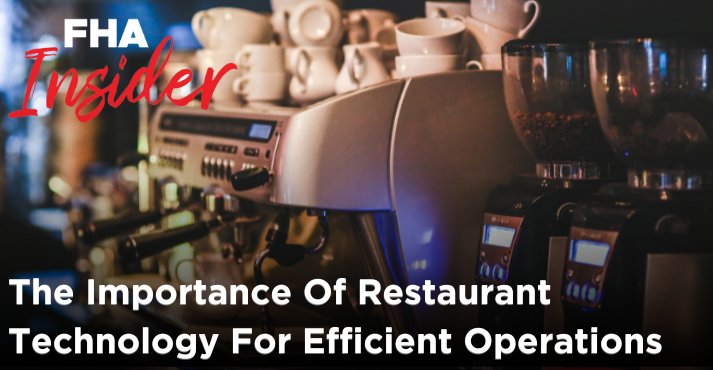
In this modern era, the way in which restaurants operate has completely changed due to the advent of restaurant technology.
These technological advancements are important as they impact customer experience and empower diners with convenience and personalization.
How does this play out practically?
Restaurants can use online reservation systems and digital menus to simplify table bookings and make use of enticing visuals as well as detailed descriptions which in turn enhances the overall dining experience and journey for the customer
Moreover, contactless ordering and payment methods prioritize safety and hygiene, offering customers a seamless and secure experience.
On the operational front, technology streamlines restaurant processes.
Kitchen automation accelerates order processing, reducing errors and enhancing communication between the kitchen and front-of-house.
Inventory management software optimizes stock control, minimizes waste, and ensures ingredient availability, boosting efficiency.
Let’s look at the importance of restaurant technologies in more detail!
Enhancing Customer Experience
- Online Reservations and Table Management
- Digital Menus and Ordering
- Contactless Payments
Online Reservations and Table Management
Online reservations and table management tools have become a way to ensure customers’ convenience and revolutionize how they book tables at restaurants—the days of making phone calls and waiting in long lines to secure a table.
Online reservation systems help in providing customers with real-time availability in restaurants allowing them to choose their desired date, time, and party size and have greater control over their dining plans. This helps restaurants in gaining higher customer satisfaction.
Moreover, online reservation systems and table management have emerged as indispensable assets in the restaurant industry; along with bringing convenience to customers, they help optimize table turnover for restaurants resulting in an overall increase in revenue.
Online reservations and table management tools have become a way to ensure customers’ convenience and revolutionize how they book tables at restaurants—the days of making phone calls and waiting in long lines to secure a table.
Table management tools allow restaurant staff to view and manage table availability in real-time and play a pivotal role in minimizing customer waiting times and optimizing table turnover by efficiently planning seating arrangements for walk-in customers.
Enhancing the customer experience has become easier with the seamless integration of online reservation systems and table management tools.
Attendees of trade shows can browse digital menus, place orders, and make special requests without the need for physical menus or lengthy interactions with waitstaff, saving time and streamlining the dining experience.
By leveraging data insights from table management tools, restaurants can optimize resource allocation, including staff scheduling and inventory management. A well-organized table turnover process ensures that the kitchen can prepare more dishes.
Additionally, table management tools provide real-time insights into reservations and seating capacities, preventing restaurants from overbooking and avoiding chaotic situations during peak hours.
Enhancing the customer experience has become easier with the seamless integration of online reservation systems and table management tools.
Digital Menus and Ordering
Digital menus and online ordering platforms offer various benefits that provide attendees with a user-friendly interface and significantly reduce wait times for orders.
Using QR code menus, contactless ordering, and streamlined food delivery, restaurants can enhance the dining experience.
This quick and easy access to digital menus eliminates waiting for physical menus, ensuring customers can begin ordering immediately, even during a busy event.
Online ordering platforms enable attendees at busy events to place orders without physical contact with menus or order sheets, reducing touchpoints and adhering to health protocols.
This leads to orders being transmitted directly to the kitchen, reducing order processing time.
This workflow allows restaurants to serve more customers efficiently in a time-constrained environment.
Using digital menus and online ordering platforms can significantly reduce wait times for orders at events like trade shows because attendees can place orders in advance or while waiting for a table.
If you are someone who prefers takeaway or delivery options, online ordering platforms can help streamline the food delivery process and efficiently manage delivery requests, ensuring timely and accurate deliveries, even during busy events.
Combining digital menus and online ordering platforms enhances the overall customer experience at events.
The convenience of quick and efficient service allows attendees to focus on networking, exploring exhibits, and attending sessions without being burdened by lengthy dining processes.
By offering quick and easy access to menus, contactless ordering for safety, and streamlined order processing, these digital solutions accelerate service and reduce wait times, creating a more efficient and satisfying dining experience for attendees.
As the demand for quick service and convenience grows, adopting these technologies becomes essential for restaurants participating in events like trade shows enhancing their competitive edge and delivering exceptional service to event attendees.
Contactless Payments
With their seamless and secure nature, contactless payments have emerged as a game-changer, changing how participants conduct transactions and ensuring safety amid bustling events such as trade shows.
Linking credit or debit cards to digital wallets, such as Apple, Google, or Samsung Pay, can help customers pay by tapping their smartphones on compatible payment terminals eliminating the need to carry physical cash or cards and reducing transaction times.
Near Field Communication (NFC) technology is crucial in contactless payments by enabling secure communication between mobile devices and payment terminals. A unique encrypted code is created that protects your sensitive card information.
This means contactless payments offer a higher security level than traditional card-based transactions.
Moreover, many attendees of trade shows prefer the convenience and security of cashless transactions, leading to an increased demand for contactless payment options.
A study conducted in 2021 found that 71% of customers at restaurants wanted to continue having contactless payment options even after the COVID-19 pandemic.
As our world moves towards a more cashless society, contactless payment solutions have become essential in supporting cashless initiatives.
Improving Operational Efficiency
- Inventory Management
- Kitchen Automation and POS Integration
- Employee Management and Scheduling

Inventory Management
Trade show events pose unique challenges for restaurants due to their fast-paced and dynamic environment. Restaurant technology, particularly inventory tracking software, plays a crucial role in optimizing stock control, reducing waste, and ensuring the availability of ingredients.
Inventory tracking software provides real-time visibility into the stock levels of ingredients and supplies, allowing restaurants to monitor their inventory continuously and proactively anticipate restocking needs.
With up-to-date data, they can maintain critical ingredients during the event, ensuring seamless operations and avoiding potential customer disappointment.
With inventory management software, restaurants can streamline ingredient replenishment processes, and the software can be set to automatically generate purchase orders when stock levels reach a predefined threshold.
This saves time and ensures that restaurants have sufficient supplies to meet the event’s high demand.
Lastly, inventory tracking software provides valuable ingredient consumption patterns and waste data. Through this data, restaurants can identify waste areas allowing restaurants to adjust their ordering quantities, refine their menu offerings, and implement better portion control to reduce food waste
Kitchen Automation and POS Integration
Ever thought about the role of technology in restaurants? Let’s dive into kitchen automation and POS system integration – how they boost efficiency and communication.
Faster Orders: Automated kitchens and POS systems speed up how orders are prepared. It’s like a digital chef making sure your food gets ready in a snap.
Reduced Mistakes: With tech in action, mistakes go down. Your order is more likely to be just right, making your dining experience smoother.
Kitchen-Front Harmony: Automation and POS systems talk. The kitchen knows what’s needed, and the front-of-house gets the details – a seamless connection.
Efficient Prep: Think of it like chefs and tech working together. Meals are prepared more efficiently and ready to be served without any hitches.
Tech-Infused Magic: Kitchen automation and POS integration bring tech to restaurants. They make orders faster, reduce errors, and ensure everyone’s on the same page.
Employee Management and Scheduling
Restaurant technology provides innovative tools to streamline staff scheduling, track time and attendance, and conduct performance analysis. These advanced solutions simplify administrative tasks and enhance workforce efficiency, productivity, and overall performance.
Employee management software simplifies staff scheduling with intelligent scheduling algorithms and real-time event data, ensuring that the correct number of staff members are available during peak hours while avoiding overstaffing during low-traffic periods.
Time and attendance software enables precise time tracking for employees. Staff members can easily clock in and out using biometric devices, mobile apps, or QR codes, eliminating the need for manual timekeeping and ensuring accurate records for payroll processing.
Lastly, labor optimization solutions help restaurants effectively manage labor costs and resources.
By analyzing historical data and real-time event attendance, these tools provide insights into staffing needs, enabling restaurants to make data-driven decisions that align labor resources with customer demand.
Data-Driven Insights and Decision Making
By gathering customer preferences and behavior data, restaurants can gain data-driven insights through customer behavior analysis and offer personalized recommendations that resonate with customers.
Customer Analytics and Personalization
Using customer analytics, restaurants can offer personalized recommendations to attendees at trade shows.
Through mobile apps or digital kiosks, personalized menus, and dish suggestions can be presented based on individual preferences, dietary restrictions, and past ordering history, enhancing the dining experience and promoting customer satisfaction.
These data-driven insights give restaurants a comprehensive understanding of customer behaviors, enabling them to make informed decisions and deliver more personalized offerings.
Lastly, through customer behavior analysis, restaurants can identify patterns and trends in customer interactions. They can understand popular dishes, peak customer traffic hours, and preferences for specific cuisines or dietary options.
This information empowers restaurants to tailor their menus and service offerings to suit the preferences of the diverse event attendees.
Business Intelligence and Reporting
Restaurant technology generates real-time reports and business intelligence at trade shows, facilitates informed decision-making, and identifies improvement areas.
By leveraging analytics dashboards, performance metrics, and data-driven insights, restaurants can gain a competitive edge, optimize operations, and deliver exceptional service during the fast-paced event.
Restaurant technology enables real-time reporting through integrated systems and digital tools; data is captured and processed in real time, providing instant access to crucial performance metrics, such as sales, order volumes, and customer feedback.
This real-time data empowers managers to monitor operations as they unfold, allowing for timely adjustments and proactive decision-making.
An analytics dashboard comprehensively views critical performance indicators (KPIs) at trade shows. Restaurants can visualize data trends, customer preferences, and operational metrics.
This allows managers to quickly identify areas that require attention and make data-driven decisions to improve service efficiency.
Harnessing restaurant technology, real-time data availability, and comprehensive business intelligence empowers managers to base their actions on objective insights rather than gut feelings.
This leads to more accurate forecasting, improved resource allocation, and better overall decision-making.
Lastly, identifying business trends allows restaurants to capitalize on emerging opportunities and stay ahead of competitors during the event.
Ensuring Safety and Hygiene
- Contactless Ordering and Menu Viewing
- Automation in Sanitization Processes
Contactless Ordering and Menu Viewing

Contactless ordering and menu viewing have emerged as crucial restaurant technology solutions to reduce physical contact and enhance safety during the event and beyond.
By leveraging QR code menus and touchless dining, restaurants can effectively adhere to safety guidelines and provide attendees with a safer and more hygienic dining experience.
Contactless ordering through QR code menus has become a hallmark of modern dining at trade shows. Attendees can access digital menus by scanning QR codes displayed on tables or using mobile devices.
This eliminates the need for physical menus, reducing touchpoints and the risk of virus transmission between customers and staff.
Moreover, touchless dining technology allows attendees to place orders and make payments without touching physical surfaces.
Through mobile apps or tablets, attendees can browse menus, place orders, and settle payments electronically, minimizing the need for direct contact with restaurant staff or shared payment terminals.
Lastly, restaurants can ensure enhanced hygiene measures by implementing contactless ordering and menu viewing.
The reduced physical contact between attendees and staff promotes a cleaner and safer environment, supporting the overall hygiene protocols of the event.
Automation in Sanitization Processes
Maintaining rigorous sanitization protocols is extremely important for ensuring the safety and well-being of customers.
With cutting-edge technologies such as UV-C sterilization and touchless dispensers, automation is vital in enhancing sanitization practices for restaurant equipment and high-touch areas.
Automation in sanitization includes using UV-C sterilization, a powerful technology that eliminates harmful microorganisms on surfaces and equipment.
Restaurants can employ UV-C sterilization devices to sanitize kitchen surfaces, dining tables, and other high-touch areas, reducing the risk of contamination and ensuring a hygienic environment.
Touchless dispensers are another essential aspect of automation in sanitization. Restaurants can promote hand hygiene by offering touchless hand sanitizers and soap dispensers.
Customers can sanitize their hands quickly and frequently, reducing the risk of spreading germs and viruses in high-traffic areas.
Automation streamlines the sanitization process, making it more efficient and consistent. UV-C sterilization devices can quickly disinfect surfaces within minutes, minimizing downtime and ensuring that areas are safe for use shortly after treatment.
By embracing automation for enhanced sanitization, restaurants demonstrate their commitment to hygienic practices and providing diners with a safe and clean environment, bolstering customer confidence and satisfaction.
Conclusion
Integrating restaurant technology into the dining experience allows the optimization of operations and ensures the safety and hygiene of customers and staff.
Using digital paying methods makes catering to international attendees, who are common at trade shows, more convenient and makes the overall experience for customers smoother.
As the hospitality industry advances, embracing restaurant technology is critical to shaping the future of dining. It enables restaurants to deliver exceptional service, stay competitive, and innovate for a seamless and satisfying dining experience.
In 2022 the food technology market was 260.07 billion U.S. dollars globally, and due to continuously advancing technologies, it is forecasted to exceed 360 billion U.S. dollars by the year 2028.
In this journey toward the future of the restaurant industry, technology remains a vital guide, paving the way for the ultimate dining transformation.












